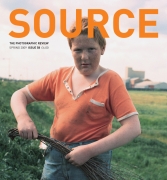EDITORIAL:
Issue 58 — Spring 2009
Issue 58 — Spring 2009
View Contents ▸
Contemporary photography is frequently said to be indebted to cinema. Art photography in particular is said to ape the appearance of films as well as the size of their pictures. However, it is not often we hear about a closer kinship between the forms: a shared usage of the projected image. The technology of projection (rather than the style of filmic pictures) means that photographs made as slides do some of the things films do: they appear in non-art spaces, like theatres or clubs (social and music); they occur in sequences that are closer to the time-based nature of films than printed photographs; and they can be accompanied by music, other recorded sound or performance. In other words, they happen live.This issue of Source is a sampling of some of the wealth of work made for projection.
One of the chief differences between film and photography has been the expense of doing it. Robin Dale was inspired by film makers like Ingmar Bergman but, without the resources available to a film director, decided to collaborate with folk musician Graeme Myles to make works with medium format slides and recorded sound. The results are a number of epic documentary works comprising hundreds of photographs with complex, multi-voiced soundtracks that describe the changing lives of entire communities in the north east of England. Talking to John Duncan, Dale describes how these works were made and shown, and introduces a selection of pictures from the sequence The Banks of the Tees.
In 1977 the Royal Photographic Society formed an Audio Visual group with its own magazine AV News. This has been a focus for a number of people interested in combining sound and projected images three of whom are interviewed here by Jesse Alexander: Sir George Pollock, Peter Coles and Colin Balls. They discuss how they became involved in producing slide sound sequences in the 60s, the ideas behind their work, and how it has been received at festivals internationally.
One of the things that appealed to Simon Starling about using a slide projector for his work Autoxylopyrocycloboros, was the way it resembled a steam engine. The projected images show a boat consuming itself (being cut up and fed into its own steam engine) as it sails in circles round a Scottish loch. The artist explains to Richard West some of the intersecting inspirations for this tragi-comic sequence, including a TV sit-com, nuclear submarines and conceptual art.
Lastly, Fiona Tait and Bram Crevits write about slide projections as part of multimedia political theatre and club culture, demonstrating both the long running influence slide projection has had and its continuing relevance today.
— The Editors





